Eager To Recognize What The Control Panel Caution Lights In Your Cars And Truck Symbolize? Explore Their Definitions For The Wellness And Safety And Security Of Your Vehicle
Eager To Recognize What The Control Panel Caution Lights In Your Cars And Truck Symbolize? Explore Their Definitions For The Wellness And Safety And Security Of Your Vehicle
Blog Article
Short Article By-Lim Corbett
When you lag the wheel, those radiant caution lights on your control panel can be a little bit perplexing. Do you know what they're trying to inform you concerning your cars and truck's wellness? Understanding the relevance of these lights is crucial for your safety and security and the longevity of your vehicle. So, the following time one of those lights appears, would not you wish to decode its message precisely and take the needed actions to resolve it?
Common Caution Lighting and Interpretations
Recognize usual caution lights in your automobile and understand their significances to make sure secure driving.
The most typical warning lights consist of the check engine light, which signals problems with the engine or emissions system. If this light comes on, it's essential to have your vehicle inspected quickly.
The oil pressure cautioning light suggests low oil stress, needing prompt attention to avoid engine damages.
A flashing battery light might suggest a faulty billing system, potentially leaving you stranded otherwise resolved.
The tire pressure monitoring system (TPMS) light signals you to low tire stress, influencing automobile security and fuel performance. Disregarding this can result in risky driving conditions.
The abdominal muscle light suggests an issue with the anti-lock braking system, jeopardizing your ability to quit rapidly in emergencies.
Lastly, the coolant temperature level cautioning light warns of engine getting too hot, which can result in extreme damages otherwise solved promptly.
Comprehending these common caution lights will help you attend to issues without delay and preserve risk-free driving problems.
Value of Prompt Interest
Comprehending the usual caution lights in your automobile is just the initial step; the significance of without delay resolving these cautions can not be highlighted sufficient to ensure your safety and security when traveling.
When marine detailers brightens on your control panel, it's your automobile's method of interacting a possible concern that needs attention. Neglecting these warnings can cause extra serious troubles down the road, compromising your safety and security and possibly costing you extra in repairs.
Motivate focus to cautioning lights can stop break downs and mishaps. For https://ecutunenearme95173.spintheblog.com/31577806/professional-viewpoints-key-practices-from-a-seasoned-vehicle-detailer , a flashing check engine light could indicate a misfire that, if left neglected, might trigger damage to the catalytic converter. Addressing this quickly can conserve you from an expensive repair work.
In a similar way, a brake system warning light may signify reduced brake fluid or used brake pads, important components for your safety and security when driving.
Do It Yourself Troubleshooting Tips
If you notice a warning light on your control panel, there are a couple of do it yourself fixing ideas you can attempt before looking for expert help.
The initial step is to consult your auto's guidebook to understand what the certain caution light indicates. In some cases the issue can be as simple as a loose gas cap activating the check engine light. Tightening the gas cap may settle the problem.
An additional typical problem is a low battery, which can set off different warning lights. Inspecting the battery links for corrosion and ensuring they're safe could deal with the trouble.
If a warning light lingers, you can attempt resetting it by separating the cars and truck's battery for a few minutes and then reconnecting it. In https://www.usatoday.com/story/tech/columnist/komando/2021/04/08/tips-help-stop-flood-deceptive-auto-warranty-robocalls/7098844002/ , checking your lorry's liquid degrees, such as oil, coolant, and brake fluid, can aid repair alerting lights connected to these systems.
Verdict
In conclusion, recognizing your vehicle's caution lights is necessary for maintaining your vehicle running smoothly and safely. By promptly addressing these signals and understanding what they mean, you can avoid expensive repair services and potential break downs.
Remember to consult your car's handbook for specific information on each cautioning light and act appropriately to make certain a hassle-free driving experience.
Remain educated, remain secure when driving!
